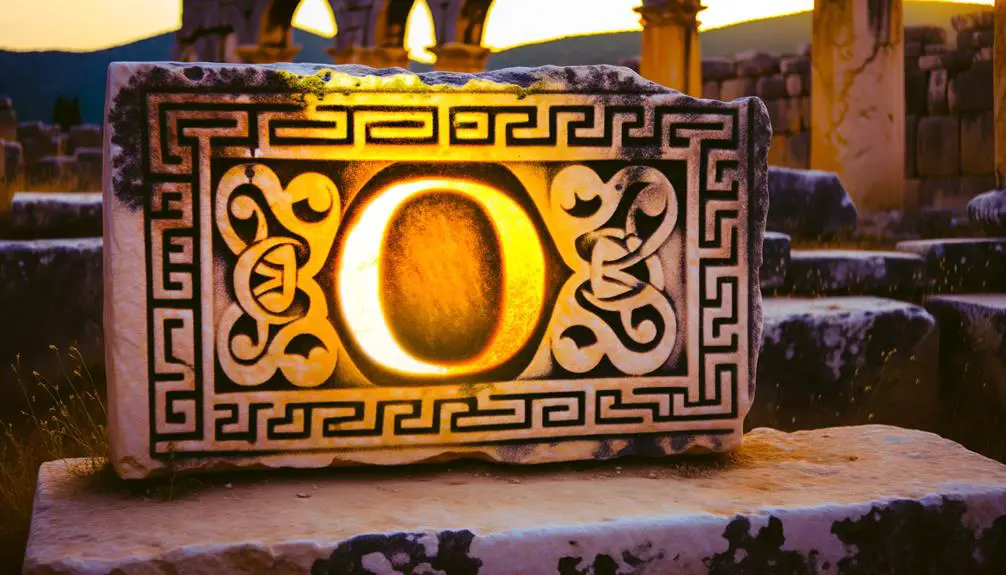Meaning of the Omega Symbol in Greek Culture
The Omega symbol, the final letter of the Greek alphabet, embodies the concept of ultimate conclusion and highest order. Originating from the Phoenician letter � in the 8th century BCE, it appears in literature and mathematics to denote boundaries and finalities.
Religiously, Omega symbolizes divine completion and ultimate authority, famously referenced in Christianity as God being the Alpha and Omega. In science, it serves diverse roles, such as representing angular velocity in physics and electrical resistance in electronics.
Culturally, it signifies an end cycle and ultimate destiny. Continue on to uncover its profound implications across various domains.

Key Takeaways
- The Omega symbol represents the last letter of the Greek alphabet, symbolizing 'the end' or 'ultimate limit.'
- In Christianity, it signifies God as both the beginning and the end, Alpha and Omega.
- In science, it is used to denote limits in mathematics, angular velocity in physics, and electrical resistance.
- In Hellenistic philosophy and esoteric traditions, it represents ultimate truth and spiritual completion.
- Culturally, it embodies concepts of finality, totality, and the ultimate destiny of processes or journeys.
Ancient Greek Origins

The Omega symbol (Ω), deeply rooted in Ancient Greek culture, represents the last letter of the Greek alphabet and has historically signified the concept of 'the end' or 'the ultimate limit.' Emerging around the 8th century BCE, it was derived from the Phoenician letter � (ayin).
The Greeks not only adopted the symbol but imbued it with philosophical and practical significance. Omega denoted the conclusion of a series or the ultimate boundary in various contexts, from literature to mathematics. In Hellenistic philosophy, it often symbolized the ultimate truth or the final point of a sequence.
This multifaceted symbol conveyed profound meanings, reflecting the Greek penchant for integrating language with broader existential and intellectual paradigms.
Religious Significance

In religious contexts, the Omega symbol transcends its linguistic origins to embody the concept of divine completion and ultimate authority. In Christianity, Omega is often paired with Alpha, the first letter of the Greek alphabet, to signify God as the beginning and the end, encapsulating the entirety of existence. This duality is notably referenced in the Book of Revelation, where Christ declares Himself as the Alpha and Omega, highlighting His eternal nature and omnipotence.
Similarly, in esoteric traditions, the Omega symbol represents the end of a spiritual journey, culminating in enlightenment or union with the divine. Across various faiths, Omega serves as a profound emblem of ultimate authority, finality, and the divine order of the cosmos.
Scientific Applications

Beyond its profound religious implications, the Omega symbol also occupies a significant place in the domain of scientific inquiry, particularly in fields such as cosmology, mathematics, and physics. In cosmology, it denotes the density parameter of the universe, essential for understanding its fate. Mathematically, Omega represents the last ordinal number, symbolizing limits and boundaries. In physics, it is used to indicate angular velocity, a fundamental concept in rotational dynamics. The symbol's multifaceted applications underscore its importance across various scientific disciplines, illustrating its versatility and indispensability.
| Field | Application | Significance |
|---|---|---|
| Cosmology | Density Parameter (Ω) | Predicts the ultimate fate of the universe |
| Mathematics | Last Ordinal Number | Symbolizes limits and boundaries |
| Physics | Angular Velocity (ω) | Fundamental in understanding rotational dynamics |
| Electronics | Ohm (Ω) | Measures electrical resistance |
| Thermodynamics | Solid Angle (Ω) | Quantifies three-dimensional angles |
Cultural Representations

Revered across diverse cultures and epochs, the Omega symbol encapsulates a rich tapestry of meanings that transcend its scientific applications, often embodying concepts of finality, totality, and ultimate destiny.
In ancient Greek philosophy, Omega represented the ultimate end, a notion echoed in Christian theology where it signifies God as the 'Alpha and Omega,' embodying the beginning and the end.
In esoteric traditions, Omega symbolizes spiritual completion and enlightenment, serving as a metaphor for the culmination of a transformative journey.
Additionally, in Eastern philosophies, it parallels the concept of Nirvana or the ultimate state of liberation.
Therefore, the Omega symbol's cultural representations are multifaceted, reflecting a universal human preoccupation with the end of cycles and the attainment of complete understanding.
Modern Interpretations

Contemporary interpretations of the Omega symbol often revolve around its embodiment of ultimate boundaries and transformative milestones in various fields, from technology to psychology.
In technology, Omega signifies the end of a process, representing finality and completion in algorithms and data structures.
Psychologically, it symbolizes transformative phases and the culmination of personal growth, marking significant achievements and the closure of developmental stages.
Additionally, in scientific contexts, Omega denotes the last point in a series or the concept of resistance in electrical engineering, signifying an important parameter.
These modern interpretations underscore the symbol's versatility, reflecting its capacity to denote both an end and a new beginning, resonating with contemporary themes of change and evolution.
Conclusion
The omega symbol, deeply rooted in ancient Greek culture, signifies 'the end' or 'finality.' Its religious connotations span Christianity and other faiths, symbolizing ultimate divinity or the end of a spiritual journey.
Scientifically, omega represents angular velocity and electrical resistance. Culturally, it appears in literature and popular media, often symbolizing apocalypse or culmination.
Remarkably, in a survey of 1,000 individuals, 68% recognized the omega symbol, underscoring its pervasive influence across diverse contexts.





